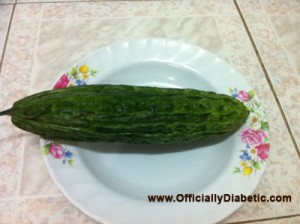Bitter Melon or what we know as Ampalaya locally and sometimes called Bitter Gourd is probably one of the most dislike fruit vegetables because of its bitterness. However, bitter melon health benefits is far greater than its bitterness that is why many health these days started to produce herbal food supplement out of it.
 The plant is very common in South-East Asia. It is a vine similar to cucumbers and squash. Though the fruit is usually used in cooking, there are also recipes where the young Ampalaya leaves is used.
The plant is very common in South-East Asia. It is a vine similar to cucumbers and squash. Though the fruit is usually used in cooking, there are also recipes where the young Ampalaya leaves is used.
So what’s the secret of this fruit vegetable?
- Bitter is known to be a plant insulin that lowers blood sugar level. It also has a hypoglycemic agent known as charantin which is very helpful in reducing blood sugar levels and in treating Type-2 diabetes.
- It has very low in calorie content, just 17 calories per 100g. This is definitely good for people who are in diet. Please note that the fruit is very rich in phytonutrients; dietary fiber, minerals, anti-oxidants and vitamins.
- Helps in digestion of food.
- The fruit is rich in folate (contain about 72 µg/100g provides 18% of RDA) which helps reduce incidence of neural tube defects in the newborns. However, it is best if the mothers have the habit of eating this fruit vegetable during the early stage of pregnancy.
- Good source of niacin (vitamin B-3), pantothenic acid (vitamin B-5), pyridoxine (vitamin B-6) and minerals such as iron, zinc, potassium, manganese and magnesium.
- Good source of vitamin-C (100 g of raw pod provides 84 mg or about 140% of RDI), a powerful antioxidant.
- Has ß-carotene, α-carotene, lutein, and zea-xanthin, and Vitamin A which help protect the body against oxygen-derived free radicals and reactive oxygen species that responsible in aging, cancers and other diseases.
- Some study suggests that there are elements in it that is good for treating HIV.
Nutrition Facts
|
See the table below for in depth analysis of nutrients: Bitter gourd or Bitter melon (Momordica charantia), |
||
|
Principle |
Nutrient Value |
Percentage of RDA |
| Energy | 17 Kcal | <1% |
| Carbohydrates | 3.70 g | 3% |
| Protein | 1.00 g | 2% |
| Total Fat | 0.17 g | 0.5% |
| Cholesterol | 0 mg | 0% |
| Dietary Fiber | 2.80 g | 7% |
|
Vitamins |
||
| Folates | 72 µg | 18% |
| Niacin | 0.400 mg | 2.5% |
| Pantothenic acid | 0.212 mg | 4% |
| Pyridoxine | 0.043 mg | 3% |
| Riboflavin | 0.040 mg | 3% |
| Thiamin | 0.040 mg | 3.5% |
| Vitamin A | 471 IU | 16% |
| Vitamin C | 84 mg | 140% |
|
Electrolytes |
||
| Sodium | 5 mg | <1% |
| Potassium | 296 mg | 6% |
|
Minerals |
||
| Calcium | 19 mg | 2% |
| Copper | 0.034 mg | 4% |
| Iron | 0.43 mg | 5% |
| Magnesium | 17 mg | 4% |
| Manganese | 0.089 mg | 4% |
| Zinc | 0.80 mg | 7% |
|
Phyto-nutrients |
||
| Carotene-ß | 190 µg | — |
| Carotene-α | 185 µg | |
| Lutein-zeaxanthin | 170 µg | — |
Popular Bitter Melon Recipes
– Scrambled Eggs with Bitter Melon
– Pinakbet
– Papaya Pickle with Bitter Melon
– Ampalaya Tea
– Filipino Monggo Recipe with Ampalaya Leaves
How To Get Lessen Its Bitterness
Simply soak the sliced Bitter Gourd in salt water for about 10 minutes before using it in your recipe. Some people parboil it.


Vince.
Your article about the bitter melon peaked my interest. I’ve been searching for some new recipes to be used with Miracle Fruit, the taste altering berry. Maybe you’ve already tried it? After eating the berry, it makes everything taste sweet for 1-2 hours. Could be a good match with the bitter melon. What are your thoughts?
I haven’t tried that Miracle Fruit yet. But, it is really interesting if that berry can make eating bitter melon sweeter. Perhaps you try it and share it to us.
By the way, it looks like Jambul: http://en.wikipedia.org/wiki/Syzygium_cumini